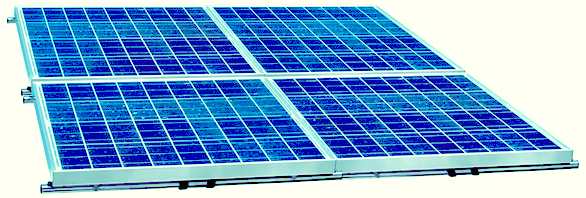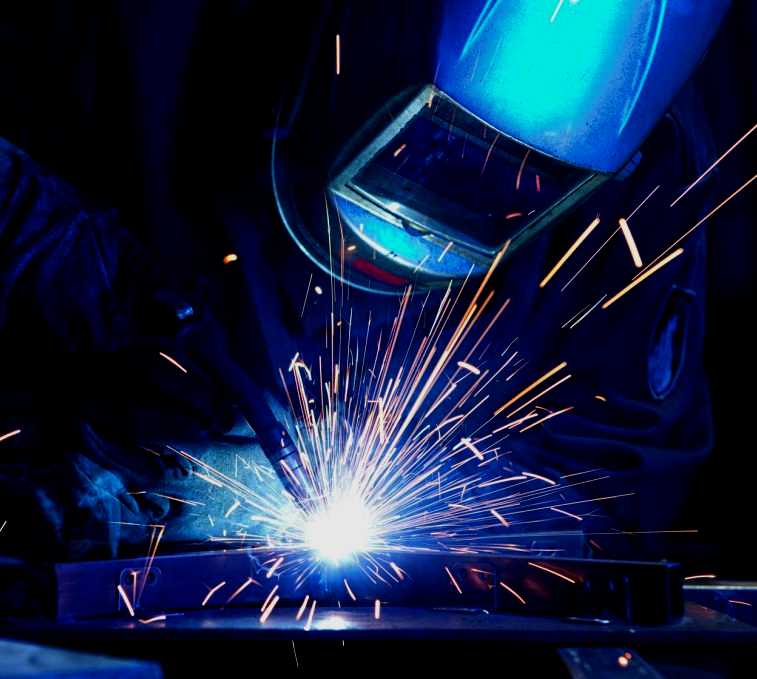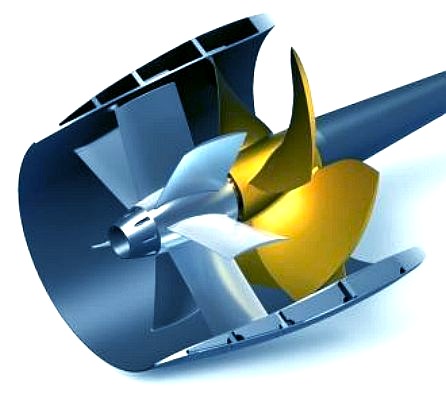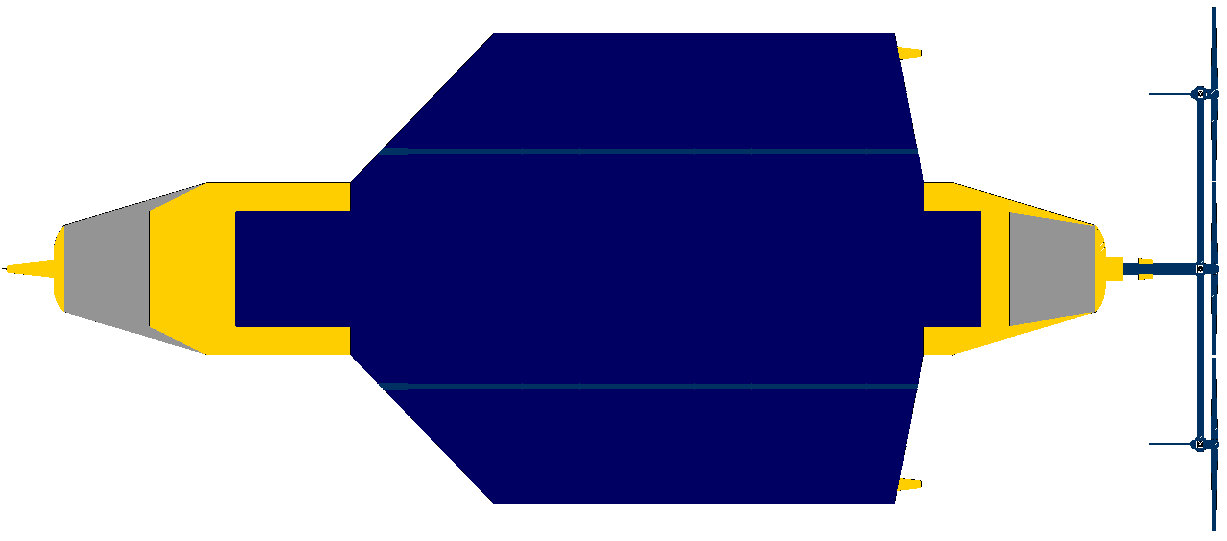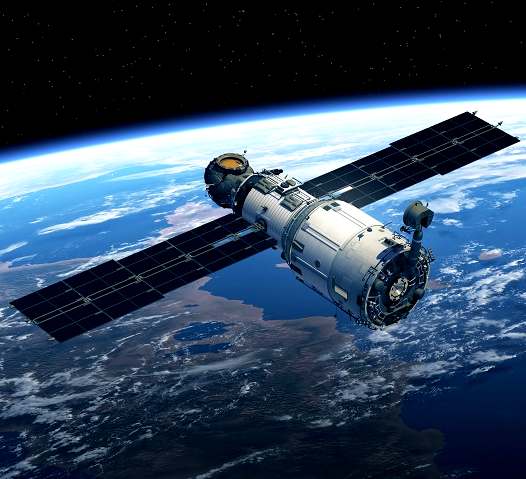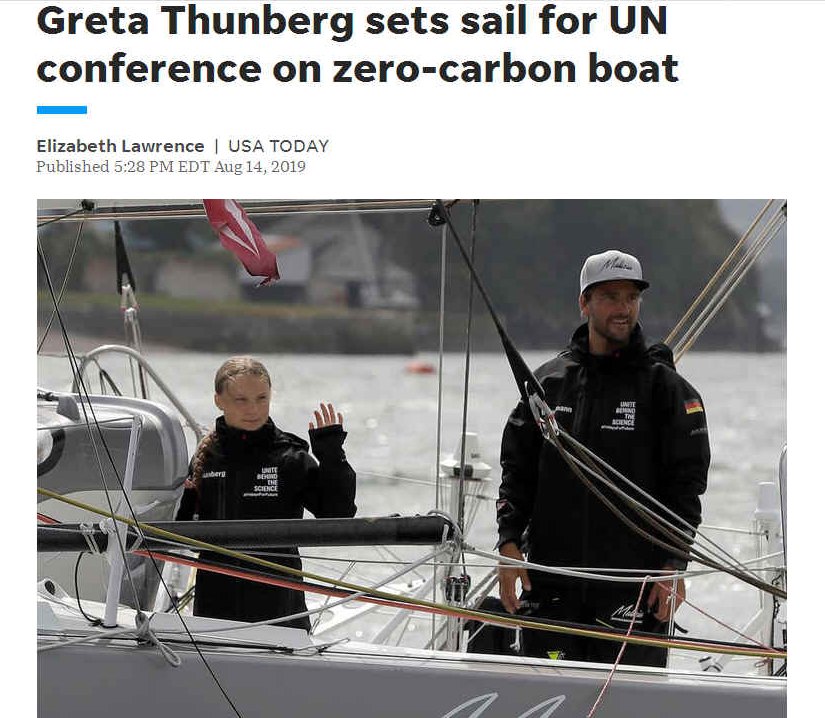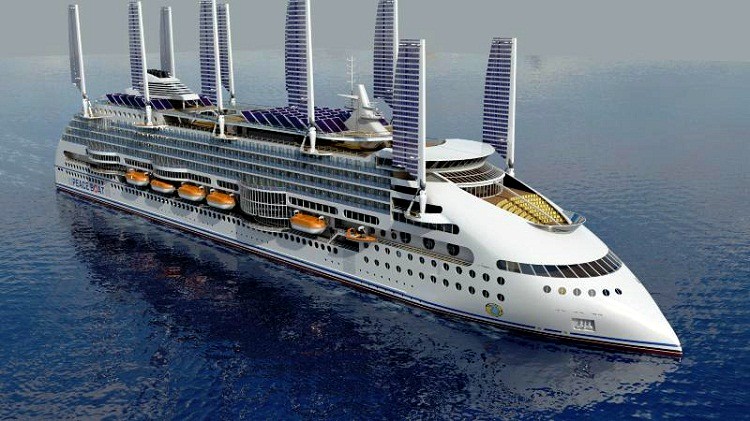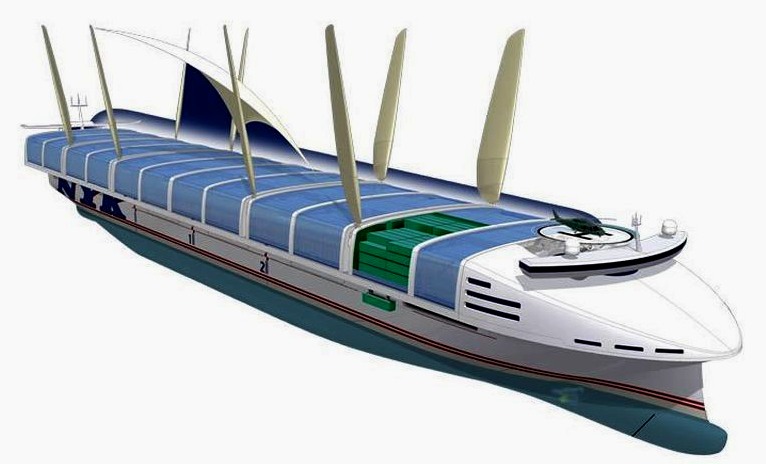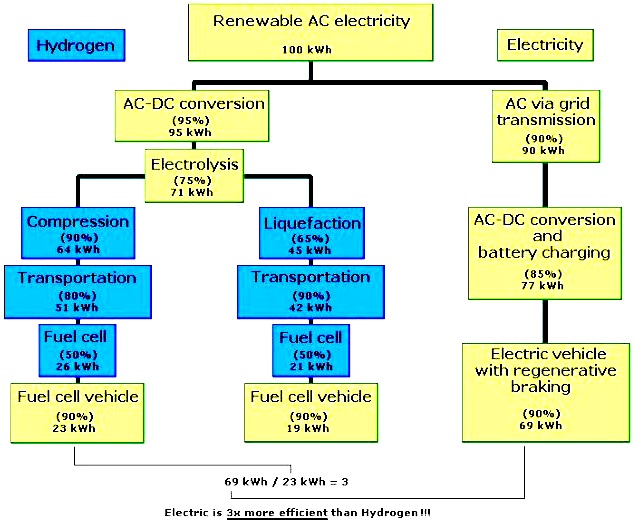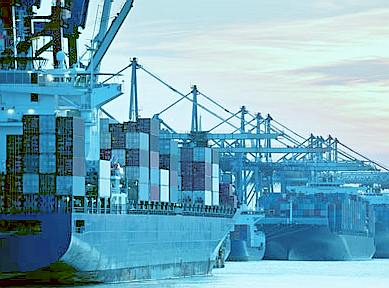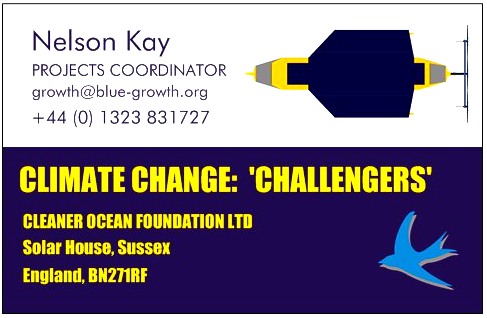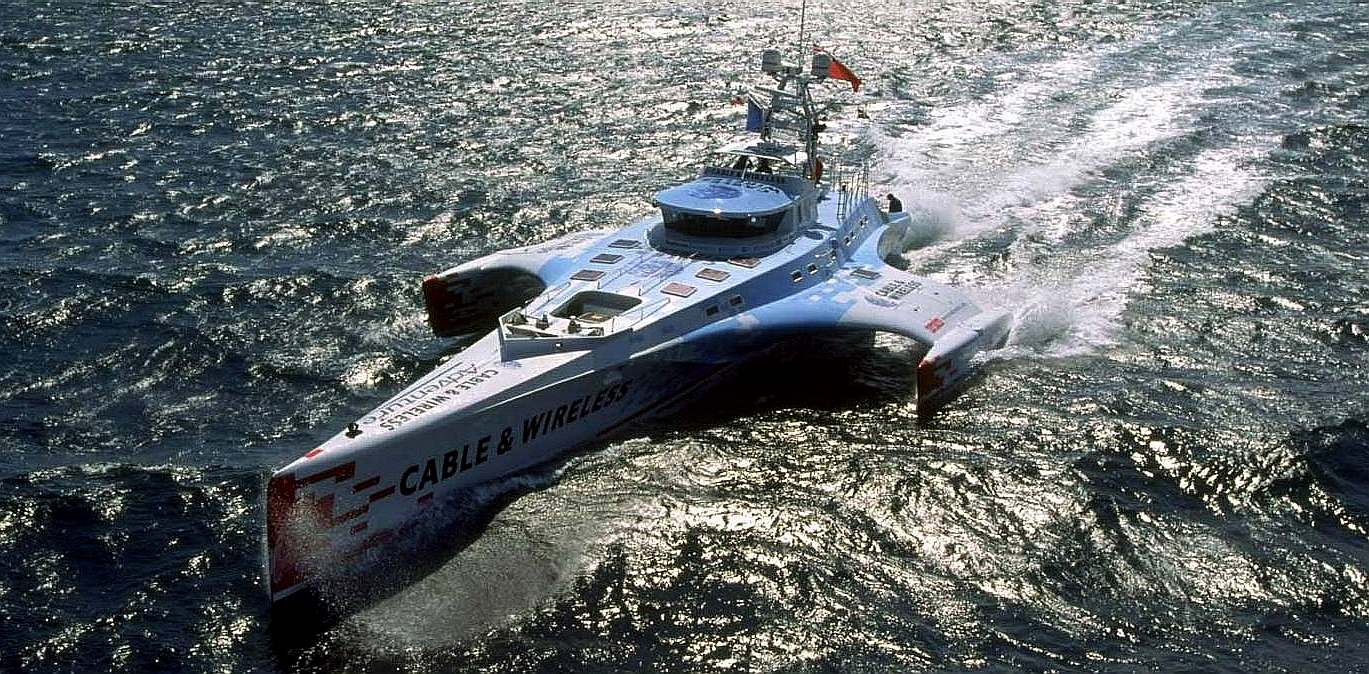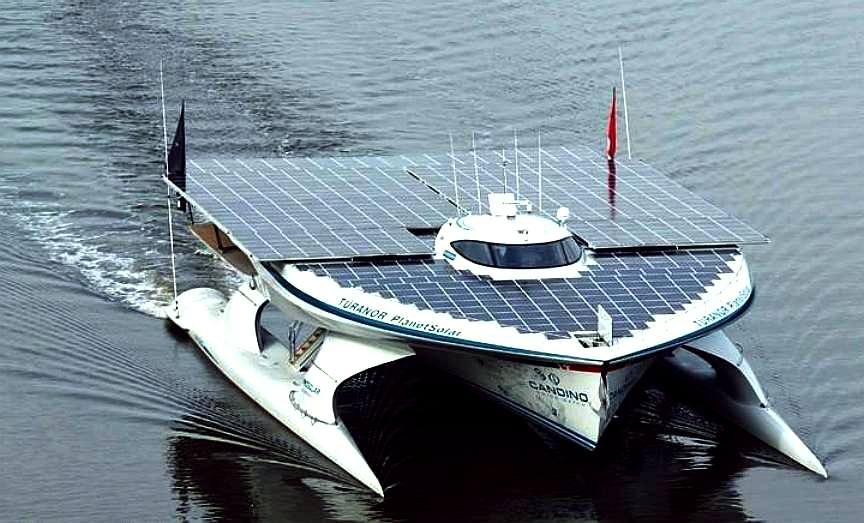|
CLIMATE CHANGE CHALLENGER
Please use our A-Z INDEX to navigate this site where page links may lead to other sites
|
|||||||||||||||||||||||||||||||||||||||||||||||||||||||||||||||||||||||||||||||||||||||||||||||||||||||||||||||||||||||||||||||||||||||||||||||||||||||||||||||||||||||||||||||||
|
|
|||||||||||||||||||||||||||||||||||||||||||||||||||||||||||||||||||||||||||||||||||||||||||||||||||||||||||||||||||||||||||||||||||||||||||||||||||||||||||||||||||||||||||||||||
ELIZABETH SWANN - Is seen here sailing toward us with solar wings unfolded to the horizontal position and the wind turbine raised half-mast. The central hull is mostly submerged with the outriggers providing stability. The vessel is seen here with four submerged thrusters, rather than conventional propellers. The hull configuration is a draft design, the subject of ongoing development and tank testing.
The Climate Change Challenge (CCC) is a project to either prove or disprove that long range blue water cargo and cruise ships might be zero carbon before 2050 or soon thereafter, given a fair wind, technical achievement and political good will. Where a lesser specified vessel might make a good coastal short hop ferry, as an example for the English Channel, this design might cross the pond to deliver passengers, eventually to provide scheduled Atlantic services. Hence this is at first, a Cross Channel record attempt, then potentially an Atlantic Challenge, like the Spirit of St. Louis was for aircraft and the Blue Ribbon is for passenger ships. But first the English Channel needs to be conquered on nothing but renewable energy by the Queen of the Seas.
The long awaited move to reduce Green House Gas (GHG) emissions from shipping presents innovators with a challenging task. Current solutions include the use of energy efficiency measures and alternative fuels applied to old hulls. But these solutions are not enough to achieve UN target reductions due to their limited potential. Current reduction measures for NOx and SOx emissions are often achieved with solutions that increase GHG emissions.
The global maritime market is set to be worth $3trillion by 2030, offering huge opportunities, but these require innovation supported by academic research. The Autonomous vessels market is growing by 15% annually. The Intelligent Systems global market is growing to $42bn. Clean Maritime, reducing emissions to meet IMO regulations, is likely to add around £16bn to economic opportunities. The IMO is aiming for a 50% reduction in GHGs by 2050, 100% by 2100. This may not be enough to reverse climate warming, hence, our clean sheet approach.
MOTIVATORS
An international team led by UK based company Cleaner Ocean Foundation Ltd, are looking for partners for collaborative innovation and research to design, build, and field (to TRL5) the world's fastest solar and wind powered craft based on the Elizabeth Swann concept seen above.
The CCC will be managed on a not for profit basis, with a view to demonstrating a formula for blue water ocean transports, the aim being to interest commercial ship builders. The concept may be scaled up from the at present medium yacht size, to cargo and cruise ships. The secret being the power to weight ratio, balanced against load carrying capacity.
The Challenge for the project team is to more than halve the circumnavigation record set in 2012 by PlanetSolar to demonstrate that practical long range zero carbon shipping is a future possibility. The previously recorded times are not considered a basis for commercial operations, despite being an amazing achievement.
PARIS AGREEMENT & MARINE ENVIRONMENT PROTECTION
COMMITTEE
In line with the Paris Agreement, the IMO’s Marine Environment Protection Committee (2018) agreed on a roadmap for developing a comprehensive strategy on the reduction of GHG emissions from ships. The initial strategy is expected to be revised in 2023, presumably in light of projects such as this and Horizon Europe priorities.
The CCC is an alternative approach to other measures that may reduce Green House Gases (GHG) in the short term, where one of the main barriers to introducing any new technology in shipping is related to financial feasibility. The CCC is a potential technological game-changer that could act as a catalyst for drastic emissions reduction, but is sure to be resisted as disruptive technology that is not understood.
There
are four main categories of CO2 reduction:
- Energy efficiency measures
- Speed reduction
- Carbon pricing (loading fuel prices to make use of alternatives attractive)
CLIMATE CHANGE CHALLENGE - "SUNSHINE" ROUTE
CLIMATE CHANGE CHALLENGE - The above table illustrates one of the most likely ocean awareness expedition routes, known as the 'Sunshine Route,' showing the time elapsed in days for 7 knots average cruising speed, including times for 5 and 6 knot averages - allowing for 10% downtime and 36 days in ports. Hence, although the objective is to reduce the current solar circumnavigation record from 584 days, the event in not an outright non-stop yacht competition in the offshore racing sense. It remains to be seen how accurate such a prediction might be. In this table we only allowed 36 days for provisioning and PR but added a 10% contingency for servicing, that could be used for additional time in ports. As a Climate Changing event, performance is one of the main criteria, especially concerning the possibilities for a transition to low carbon shipping and the contribution this might make in combating global warming. UK project team. This phase of the project is set to be funded by responsible corporations.
2050 TARGET
This 2050 target is based on the assumption that within 3 years a team of engineers might produce and test a suitable vessel, and that thereafter and within a further 7 years the concept is up-scaled to full scale prototypes for shipyards to be able to construct cargo ships and cruise liners based on the original design.
Assuming that funding is available from 2020, that should mean a conclusion of the "Challenge" by 2023. If successful, the design may be up-scaled and tested as tank models within 7 years of completion of the 'Challenge', taking the development of the concept to 2030.
Attempting to model a complex problem, such as expected shipping activity over a period of 35 years and potential solutions for reducing emissions, involves significant uncertainties.
From 2030 vessels may be built to replace the current fleet of cargo ships, as the older transports reach the end of their 20 year useful working lives.
In order to accelerate such ideal, a scrappage scheme might be introduced, where older bunker fuelled vessels are traded in for an allowance against an purchase order for a Zero Carbon ship.
In addition, cargo and passengers that are delivered via diesel engines or coal fired boilers could be subject to an international marine tax on gallons of fuel used or tons of coal burned, which taxes will go toward building up a fund for scrap-age trade-ins.
SPEED REDUCTION LOGISTICS
A relatively simple way to reduce fuel consumption and emissions is speed reduction. The industry has already introduced slow steaming in many segments and a further 10-20% reduction could be possible without major change in equipment or logistics.
This would correspond to a reduction in fuel consumption in the order of 30% in the short term, also accounting for the fact that more vessels will be needed to cover the transport demand.
Slow steaming makes solar powered shipping more attractive, tending to level the playing field. Where speed is to be reduced by more than 20% leading up to 2050, established logistics solutions and charter contracts will need to be reviewed.
SMALLER SHIPS IN BIGGER NUMBERS
The ability to handle a larger number of smaller ships, means that ports and harbours may need to revise berthing and loading arrangements for a quicker turnaround. It also means that smaller and more frequent consignments might be catered for with regular sailing times and that investment in new ships may be in smaller bites - so easier to transition.
At this stage it is impossible to guess at the advantages or disadvantages of electric ocean transport, until we know how well the 'Climate Change Challenger' might perform. Once that data is available, computer modelling might allow us to determine workability scenarios.
TRANSFERABLE TECHNOLOGY - The design of the Climate Change Challenger might be adapted to Cargo, Container, Cruise and Ferry designs, without needing to radically alter port facilities. The designs above are not representative of adaptations of the concept, but serve to illustrate the thinking of other design houses.
FUEL CELLS & LIQUID HYDROGEN vs SOLAR & BATTERY
Unfortunately, hydrogen ships are not that green in terms of converting sunlight or wind power into propulsive force at the propeller shaft. That does not mean hydrogen does not have a role to play. It just means we need to be realistic - and accept that we'll get less total energy out, but greater energy density.
Hydrogen Fuel Cell (HFC) vehicles are perceived to be a good bridge between fossil fuels and full electric because:
- Hydrogen fuel cells are thought to last longer than batteries (or conversely, batteries are thought to have a shorter life).
- Hydrogen as a fuel is perceived to offer relatively small infrastructural changes from fossil fuels.
- Hydrogen is perceived as a cleaner solution than diesel or natural gas or LPG.
- Green hydrogen offers virtually unlimited energy potential.
In
reality:
- Hydrogen storage is inefficient, energetically, volumetrically and with respect to weight.
- There is no infrastructure for distributing or even making hydrogen in large quantities. There probably won’t be for at least 20 or 30 years, even if we start building it today like there was no tomorrow.
-
Solar and wind charged battery electric vehicles are a better
bet given the speed of technological developments past, present and future.
HYBRID
FERRIES Caledonian Maritime Assets Limited (CAML) owns ferries, ports and harbours and infrastructure necessary for vital ferry services serving the west coast of Scotland and the Clyde Estuary, and the Northern Isles.
CAML are wholly owned by the Scottish Government with Scottish Ministers the sole shareholders.
They aim to provide efficient, cost-effective and safe ferries, harbours and port infrastructure for operators, communities and users in and around Scotland.
BIOFUELS and SCRUBBERS
Use of biofuels in large quantities is likely to strain the balance in terms of agricultural land that is needed to grow food, where desertification is already on the UN agenda against the need to feed a growing population and stave off famine in the face of reducing fish stocks. This is a food security issue that must be taken into account in deciding policy and law, especially where clearing of forests to create farmland means lowering carbon absorption and oxygen production from trees.
Using CO2 scrubbers to comply with low sulphur standards may be a financially attractive option in the short term to keep old ships steaming, but such investment tends to lock the industry into a fuel that does not allow for significant GHG emissions reductions for the bigger picture. Using LNG or LPG as fuel can contribute to small GHG reductions. Scrubbers will result in higher total emissions.
CONVERSIONS
The introduction of energy efficiency measures and speed reduction are the only practical means of reducing GHG emissions for most existing vessels. Retrofitting to use less carbon intensive fuels is possible, but usually very costly. Very few vessels are therefore expected to undertake such conversion projects. Especially if there is a scrappage scheme in the making.
FINANCE
Ship owners tend to have short term investment plans of between two and five years. This frustrates the take up of new technology with longer term payback against a background of political uncertainty. This is not such a pronounced problem if ships are smaller, so representing a lesser per-unit risk.
There are two major types of uncertainties: a) technological; b) market and regulatory uncertainties.
Other than technical barriers, access to finance and low operating margins in many shipping segments lead to very short investment terms, further complicating the uptake of technologies that could lead to decarbonisation of shipping operations.
One thing that is unchanging is that the sun will shine and the wind will blow.
LOW TECH - This is a design for a budget cross channel transport, based on a patent, the IP rights of which have been gifted to the project. This boat is also a trimaran, but the hull configuration is different and this multi-hull is smaller at just a shade over 15 meters. Whereas the World Challenger project above is nearly three times in size. The World Challenger uses a lot of technology that needs to be developed if shipping is to advance significantly in the next 30 years to meet IMO targets. This small ferry has no frills and a lower power to weight ratio, based on lead-acid storage. The cost of build in the broad scheme of things is a drop in the ocean compared to ferries in service, but could provide the data needed to compare to other feasibility studies, such as those based on hydrogen as the fuel source.
The wind turbines are in-effect rotary sails. As rotary sails a 40mph wind on two 5m diameter rotary sails would generate a theoretical 767kg of force (thrust) [1,690lbs]. On two 4m dia sails: 494kg [1089lbs]. Wind speed is of course variable and directional, but on average the forces generated will decrease passage time. For larger vessels traversing trade routes, the advantage could be considerable. For this budget experiment, we'd be using 2.25m diameter turbines that might be upgraded to 5m for ongoing experiments. This formula could be applied to the Atlantic Challenge in proportion to length and beam.
REFERENCES
“Neste Renewable Diesel Handbook”, Neste, 2016.
“Technologies and measures for energy efficiency of ships”, E. Dale, H. Gundersen, M.S. Eide, DNV GL, Report for Enova SF (in Norwegian), 2016: https://www.enova.no/upload_images/5CA0E9A81AD54C4C94C3B313AB238A27.pdf
“Third IMO GHG Study 2014”, T. Smith et al., International Maritime Organization (IMO), London, UK, 2015.
“Technology Roadmap – Hydrogen and Fuel Cells”, IEA, 2015.
“Renewable energy powertrain options for Ruter”, Roland Berger, 2015.
Climate Change 2014, Synthesis Report”, IPCC, 2015: https://www.ipcc.ch/pdf/assessment-report/ar5/syr/SYR_AR5_FINAL_full_wcover.pdf
“Potential for Shore side electricity in Europe”, R. Winkel et al.,
Ecofys, 2015:
“Alternative Fuels for Marine Applications”,
IEA, 2014:
CONTACTS
Climate Change Challengers Cleaner Ocean Foundation & Bluebird Marine Systems Ltd Solar Studios BN271RF United Kingdom growth@blue-growth.org
LINKS & REFERENCES
https://www.cmassets.co.uk/feasibility-study-using-hydrogen-produced-from-local-wind-farms-to-power-future-ferry-services/ https://www.cmassets.co.uk/ferries/ http://www.climatechangechallenge.org/ http://www.blue-growth.org
STABILIZED MONOHULL - The diesel powered Cable and Wireless Adventurer was built for the purpose of circumnavigating the world in less than 80 days. This was successfully accomplished in July 1998 in 74 days, 20 hours, 58 minutes, traveling more than 22,600 nautical miles (26,000 miles or 41,855 km). This achievement set a new Guinness World Record for a diesel powered vessel. The nautical mile or knot, is a unit of speed equal to approximately 1.15078 miles per hour on land (1.852 km).
GUINNESS BOOK OF RECORDS - MS Turanor PlanetSolar (Switzerland) navigated the world in a westward direction from Monaco in 1 year 7 months and 7 days from 27 September 2010 to 4 May 2012. We wonder why nobody has attempted to improve on this design, to challenge the record in the intervening seven years.
Please use our A-Z INDEX to navigate this site
|
|||||||||||||||||||||||||||||||||||||||||||||||||||||||||||||||||||||||||||||||||||||||||||||||||||||||||||||||||||||||||||||||||||||||||||||||||||||||||||||||||||||||||||||||||
|
This website is provided on a free basis as a public information service. copyright © Climate Change Trust 2020. Solar Studios, BN271RF, United Kingdom.
|
|||||||||||||||||||||||||||||||||||||||||||||||||||||||||||||||||||||||||||||||||||||||||||||||||||||||||||||||||||||||||||||||||||||||||||||||||||||||||||||||||||||||||||||||||

